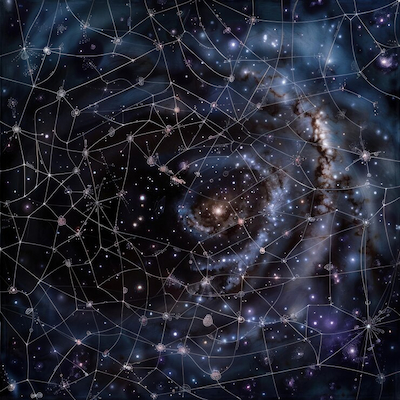
The large-scale structure of the universe is one of the most fascinating topics in modern astronomy. It refers to the distribution of galaxies, galaxy clusters, and other cosmic formations that make up the cosmic web. This web is formed by filaments of dark matter and galaxies connected in a complex network, creating a structure that spans billions of light-years. Understanding this structure is fundamental to uncovering the mysteries of the cosmos, such as galaxy formation and the evolution of the universe.
Studying cosmic webs allows us to understand how gravity and dark matter interact to shape the universe. Additionally, analyzing these structures can reveal valuable information about dark energy, a mysterious force accelerating the expansion of the universe. As astronomers develop new technologies and observation methods, research on large-scale structure and cosmic webs continues to evolve, offering new perspectives on our understanding of the cosmos.
How Large-Scale Structures and Cosmic Webs Work
Large-scale structures in the universe function through a complex interplay of gravitational forces acting on visible and dark matter. Dark matter, which does not emit light and is invisible, makes up the majority of the universe’s mass. Its presence is detected indirectly through its gravitational influence on visible matter. As dark matter accumulates, it forms a “skeleton” that attracts galaxies and galaxy clusters, creating the filaments that characterize the cosmic web.
The formation of these structures begins with small density fluctuations in the early universe, which are amplified over time due to gravity. These fluctuations lead to the formation of gas and dust clouds that eventually condense into stars and galaxies. As galaxies cluster, they connect through dark matter filaments, forming a network observable on large scales. This network includes dense regions where galaxies concentrate and voids with little matter.
The dynamics of the universe’s expansion play a crucial role in the formation of large-scale structures. Since the Big Bang, the universe has been expanding, and the rate of this expansion is influenced by dark energy. This mysterious energy not only accelerates expansion but also affects structure formation, as gravity and dark energy act in opposing directions. The balance between these forces determines the distribution of galaxies and clusters in space.
Observation and modeling of these structures are conducted through computer simulations and telescopes that capture light from distant galaxies. These tools allow scientists to map galaxy and dark matter distribution, helping build a more complete picture of the cosmic web and its properties. Observations across different wavelengths—radio, infrared, and optical—provide a comprehensive view of the interactions shaping the universe.

Advantages of Studying Large-Scale Structure and Cosmic Webs
Studying large-scale structure and cosmic webs offers several advantages that are fundamental to the advancement of astronomy and cosmology. One of the main advantages is the ability to understand matter distribution in the universe. By mapping galaxies and dark matter, scientists can identify how gravity influences structure formation and how these structures evolve over time. This knowledge is essential for understanding the universe’s history and galaxy formation.
Another significant advantage is the potential to investigate the nature of dark matter and dark energy. Large-scale structure serves as a natural laboratory for studying these mysterious components of the universe. By analyzing galaxy distribution and gravitational effects, researchers can infer properties of dark matter and dark energy, helping to answer fundamental questions about the universe’s composition.
Additionally, studying cosmic webs can provide insights into galaxy evolution. Interactions between galaxies in clusters and filaments can lead to mergers and interactions that shape their characteristics. Understanding these processes is crucial for unraveling the history of galaxies and how they transform over time. This also helps explain star formation and the evolution of planetary systems.
Research on large-scale structures and cosmic webs has practical implications for observational astronomy. Techniques and methods developed for studying these structures can be applied in other areas of astronomy, such as astrophysics and cosmology. Moreover, international collaboration in cosmic web research promotes knowledge exchange and technological advancement, enriching the global scientific community.
How to Identify and Analyze Large-Scale Structures and Cosmic Webs
Identifying and analyzing large-scale structures and cosmic webs involves a combination of observational and computational techniques. Astronomers use different types of telescopes—optical, radio, and infrared—to capture images and spectra of galaxies and clusters. These data are processed and analyzed to map galaxy distribution and detect the presence of dark matter.
One common approach to identifying structures is mapping galaxies across large sky areas. Projects like the Sloan Digital Sky Survey (SDSS) have collected extensive data on the position and luminosity of millions of galaxies. These data are used to create three-dimensional maps of the universe, allowing scientists to visualize galaxy distribution.
Another important technique is computer simulation. Simulation models are used to represent the universe at different scales, considering gravitational interactions and matter evolution over time. These simulations help predict how large-scale structures form and evolve, enabling researchers to compare theoretical results with real observations.
Statistical analysis plays a crucial role in identifying large-scale structures. Scientists use statistical methods to quantify galaxy distribution and identify patterns indicating filaments and voids. These methods help validate structure formation theories and better understand universe dynamics.
Collaboration between disciplines such as astrophysics, cosmology, and particle physics is essential for a comprehensive understanding of large-scale structures. Knowledge sharing and interdisciplinary cooperation contribute to research advancement and building a more complete picture of the cosmic web.
- Galaxy Observation: Use optical and radio telescopes to map galaxy distribution across large sky areas.
- Computational Simulations: Create models simulating universe evolution and large-scale structure formation.
- Statistical Analysis: Apply statistical methods to quantify galaxy distribution and identify patterns.
- Interdisciplinary Collaboration: Work with experts from different fields to enrich research on cosmic structures.
- Use of Project Data: Leverage data from projects like SDSS for comprehensive galaxy information.
- Theoretical and Observational Comparison: Compare simulation results with observational data to validate structure formation theories.
Identifying and analyzing large-scale structures and cosmic webs is a complex process but essential for understanding the universe. Each technique and approach contributes to a deeper understanding of the interactions and dynamics that shape the cosmos.

Did You Enjoy Learning About Large-Scale Structure and Cosmic Webs?
Large-scale structure and cosmic webs are fascinating topics that reveal much about the nature of the universe. By studying these structures, scientists not only uncover mysteries of gravity and dark matter but also expand our knowledge of cosmic evolution. Research in this area continues to grow, promising new discoveries and insights.
If you found this topic interesting, there is much more to explore! Astronomy is constantly evolving, and new technologies and observation methods are always being developed. Keep following the news and discover how science is unraveling the secrets of the universe we live in.
Frequently Asked Questions
What is large-scale structure and cosmic webs?
Large-scale structure and cosmic webs are the vast formations of the universe. Think galaxies, groups, and clusters.
How do cosmic webs form?
They form through gravity. Dark matter pulls on normal matter and creates these webs. It acts like a magnet drawing everything together.
Why is large-scale structure important?
It helps us understand how the universe evolved. Without it, it would be difficult to know where we are in the cosmos.
Where can I see examples of cosmic webs?
Scientists use powerful telescopes. They study sky images and reveal the structures.
Do cosmic webs impact life on Earth?
Yes, they influence gravity and galaxy formation. This can indirectly affect our planet.
How do cosmic filaments influence galaxy formation?
Cosmic filaments provide the gravitational framework along which galaxies and galaxy clusters form and evolve. Matter flows along these filaments, accumulating at intersections where large structures like clusters emerge. These filaments guide the distribution and motion of matter, playing a crucial role in shaping the cosmic web.
Can we see the cosmic web directly?
We cannot see the cosmic web with the naked eye, but astronomers can detect it through observations of galaxy distributions, gravitational lensing, and the intergalactic medium. Using powerful telescopes and simulations, scientists reconstruct 3D maps of these large-scale structures, revealing the web-like pattern of matter in the universe.

